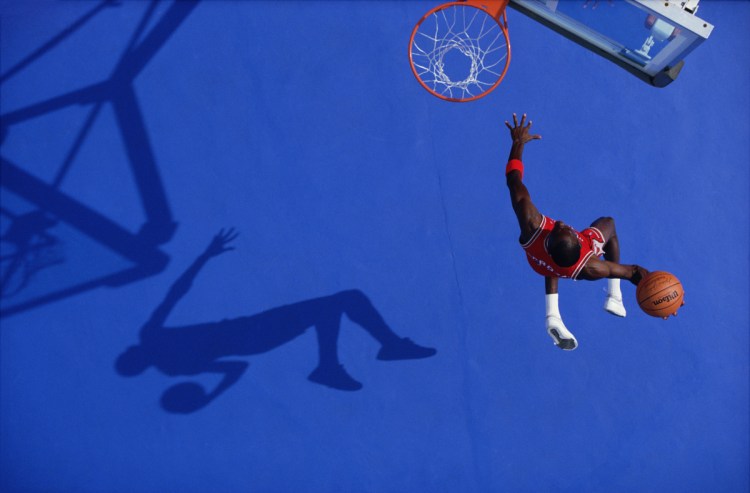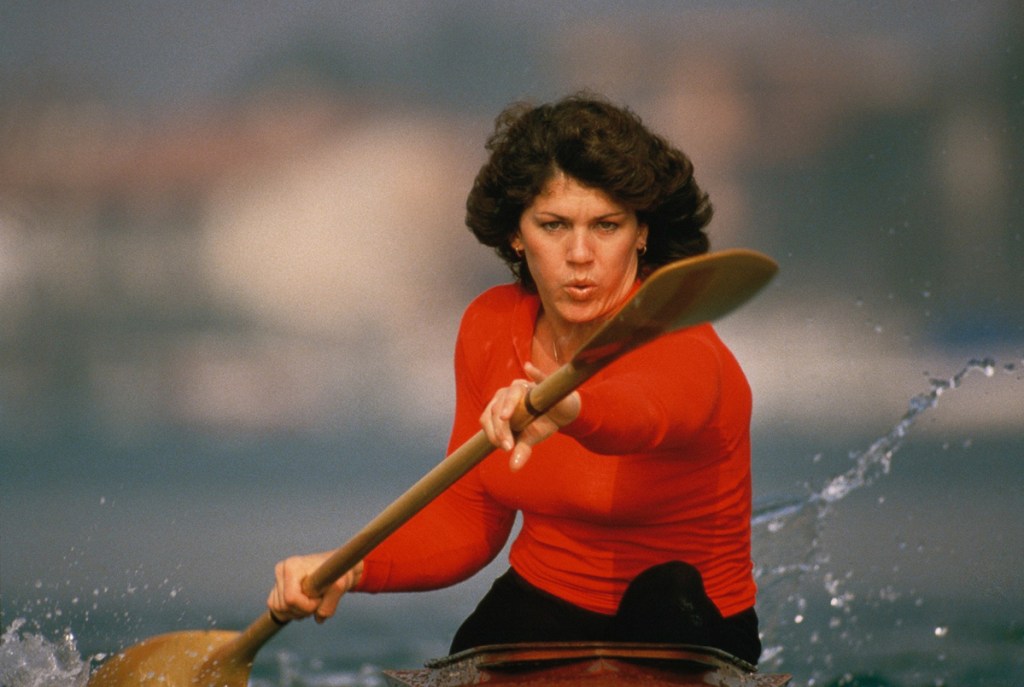Even if you are not interested in sports, “Game Time: The Sports Photography of Walter Iooss” might change your thinking about both sports photography and sports. I certainly didn’t expect such an emotional response, but Iooss is a master of both the formal and human dimensions of photography. His work is inspired and inspiring.
It’s almost impossible that you haven’t seen Iooss’s work. It has been featured on more than 300 covers of Sports Illustrated, a magazine to which Iooss (born in 1945) has contributed for more than 50 years. Even if you’re not a sports fan, you will undoubtedly have seen his work as, for example, Atlantic Records’ in-house photographer from 1968-1972. His subjects there included Jimi Hendrix, Janis Joplin and James Brown – images which are (regrettably) not included in “Game Time.”
Among the works on view at Colby are several highly recognizable images that rise to the level of iconic. Possibly his best-known image is from the 1982 NFC championship game when Dwight Clark stretched to catch Joe Montana’s pass: a game-winner with less than a minute left. The play has come to be known as “The Catch.”
But this in-game narrative is an exception. Only about three of the 50 or so works on display fit this model, and none with the specificity of “The Catch.” Iooss’s particular ability is to capture the humanity of his subjects. Sometimes, through their celebrity, we already know their greatness. Sometimes Iooss shows it to us. And sometimes he gives us snapshot-like portraits: the regular-people side of great athletes.
This is precisely where Iooss is best served by Colby’s curatorial presentation. I might have recognized Dave Parker from 1980; he was the National League’s MVP in 1978 and those old Pittsburgh Pirates baseball hats were one of America’s most forgettable fashion statements. But to see Parker chilling in the dugout with a few teammates smoking — well, that’s an image. But it was the label copy that astonished me: Parker was the first professional athlete to get a million dollar salary. So what, you might ask? Parker is black.

“The Catch,” Jan. 10, 1982, Dwight Clark from Joe Montana, Candlestick Park, San Francisco, (printed later), archival pigment print, 20 by 24 inches.
This kind of insight pops out everywhere in “Game Time.” And it’s not as simple as straight-forward identity politics. It’s about human endeavor, excellence, achievement and struggle. Iooss shows us, for example, Arnold Palmer and Jack Nicklaus chatting in the clubhouse during a golf tournament. Palmer is expectedly animated, and Nicklaus is (just as predictably) serious. Colby’s label then explains how the rivals (and friends) carved up the tournaments as equally as possible: In the 1960s, Nicklaus won 30 tournaments, only one more than Palmer. Iooss takes this approach deepest with his images of women’s tennis. We see Martina Navratilova and Chris Evert maybe more than any other athletes in “Game Time,” but here they are together, bowing to an unseen monarch. (It is Wimbledon in 1982, after all.) Between 1975 and 1987, the label informs us, there were only 23 weeks when one of them wasn’t the top ranked player in the world. Wow: That’s dominance even a queen could envy.
I was particularly moved by Iooss’s image of Billie Jean King. We see the powerful and aggressive player in a pensive moment at Wimbledon, looking at her racket between points. We learn the image is from King’s final Wimbledon title – her 20th, a doubles championship with her partner, Navratilova – but also learn about King’s victorious efforts on behalf of equal pay for women champions and Title IX, an important gender equality law addressing educational funding.

Billie Jean King, Wimbledon, 1979 (printed later), archival pigment print, 20 by 24 inches.
Included among the star-studded shots are images of kids playing ball in Cuba and child kickboxers in Thailand. These images go a long way to show Iooss’s ability to convey excellent narrative photography even when we don’t (and can’t) know the story. We see plenty of images that prove his eye: Julius Erving in a black and white spotlight oval, a woman diver perched perfectly with only her toes still on the board, a gymnast who is unidentifiably blurred but incomparably graceful, a shirtless Michael Jordan in a black-and-white three-quarters classical pose, and Greg Louganis diving but inverted so that the blurred red lights about him seem to leap like flames grabbing at a triumphant superhero.
We read about Louganis again in the label for a grinning 1996 image of Magic Johnson. In 1991, Johnson announced he was HIV positive. And yet he was still able to be the MVP of the 1992 NBA All-Star game and win a gold medal with USA’s “Dream Team” in the 1992 Olympics. Johnson returned to play 32 NBA games in 1996. Louganis’s 1995 announcement that he was HIV positive also helped grow international awareness about HIV/AIDS. Inspiring stuff.
What Iooss brings to photography is a masterful eye and a deep empathy for his subjects. From the time he shot his first role of film at a football game at the age of 17, he brought a sports fan’s enthusiasm. Sports, after all, are intentionally theatrical and visual. Competition means narrative that, unlike theather, is not contrived. It’s personal. It’s undetermined. We see this with the cocky Joe Namath sunbathing like a playboy just before the third Super Bowl and making his unlikely (but correct) prediction of a resounding victory over the heavily-favored Colts. We see this even more poignantly as Muhammad Ali pounds Ernie Terrell. Ali had just converted to Islam and so had just changed his name from Cassius Clay. Terrell refused to call him “Ali.” So Ali screamed, “What’s my name!” between the merciless blows he delivered to Terrell, including the left uppercut he lands between Terrell’s covering arms. We also see this in the iconic image of Sandy Koufax pitching the complete Game 7 shutout to win the 1965 World Series: Koufax, who is Jewish, had famously refused to pitch the first game of the series because it coincided with Yom Kippur.

Bill Russell and Elgin Baylor, Los Angeles, 1966 (printed later), archival pigment print, 20 by 24 inches.
Western art was long all about narrative, specifically religious narrative. But it is through this lens that we cultivated our visual culture: story, conflict, outcome, perspective, battle, struggle, character, portraiture, ethics, strength – in short, “the thrill of victory and the agony of defeat.” Iooss is on the short list of our most visible cultural authors: His photographs have been seen hundreds of millions of times (perhaps billions) by Americans and people around the world. But what does this mean for the viewer who walks into the Colby College Museum of Art? What is the role of celebrity, of familiarity? In terms of “Game Time,” I think the experience remains with the viewer and the image. Iooss could have become the most famous culture photographer in America, but he is not – not yet at least. Perhaps his images hide him behind his subjects. And perhaps that is for the best. Whatever you think of Iooss and his brand of photography, “Game Time” is a beautiful and inspiring exhibition.
Freelance writer Daniel Kany is an art historian who lives in Cumberland. He can be contacted at:
dankany@gmail.com
Send questions/comments to the editors.



